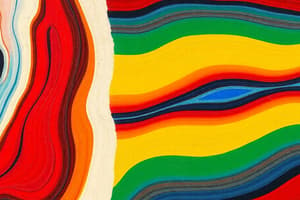Podcast
Questions and Answers
What is the primary cause of plate movements in tectonics?
What is the primary cause of plate movements in tectonics?
- Magnetic forces from the Earth's core
- Gravitational attraction between plates
- Pressure from the Earth's crust
- Convection currents in the semi-fluid asthenosphere (correct)
Which type of plate boundary is characterized by plates moving apart?
Which type of plate boundary is characterized by plates moving apart?
- Convergent Boundary
- Transform Boundary
- Static Boundary
- Divergent Boundary (correct)
What geological feature is most commonly associated with convergent boundaries?
What geological feature is most commonly associated with convergent boundaries?
- Earthquakes
- Mid-ocean ridges
- Mountain ranges (correct)
- Volcanoes
Which of the following statements about tectonic plates is correct?
Which of the following statements about tectonic plates is correct?
What does 'slab pull' refer to in plate tectonic theory?
What does 'slab pull' refer to in plate tectonic theory?
Which of the following events is least likely to occur at transform boundaries?
Which of the following events is least likely to occur at transform boundaries?
How did the theory of plate tectonics gain acceptance in the mid-20th century?
How did the theory of plate tectonics gain acceptance in the mid-20th century?
Which significant geological phenomena are associated with tectonic plate movements?
Which significant geological phenomena are associated with tectonic plate movements?
Flashcards are hidden until you start studying
Study Notes
Overview of Plate Tectonics
- Definition: A scientific theory explaining the movement of the Earth's lithosphere, which is divided into tectonic plates.
- Lithosphere: The rigid outer layer of the Earth, comprising the crust and the upper mantle.
Key Concepts
-
Tectonic Plates:
- Large, rigid pieces of the Earth's lithosphere.
- Move on the semi-fluid asthenosphere beneath them.
- Major plates include:
- North American Plate
- South American Plate
- Eurasian Plate
- African Plate
- Indo-Australian Plate
- Pacific Plate
- Antarctic Plate
-
Plate Boundaries:
- Divergent Boundaries: Plates move apart, creating new crust (e.g., Mid-Atlantic Ridge).
- Convergent Boundaries: Plates move toward each other, often causing one to subduct beneath the other (e.g., Himalayas, Andes).
- Transform Boundaries: Plates slide past each other, causing earthquakes (e.g., San Andreas Fault).
-
Plate Movement Mechanisms:
- Convection Currents: Heat from the Earth's core causes magma to move, driving tectonic plate motions.
- Ridge Push: New material at divergent boundaries pushes plates apart.
- Slab Pull: The weight of a subducting plate pulls the rest of the plate down.
Geological Activity
- Earthquakes: Result from stress accumulation and release at plate boundaries.
- Volcanoes: Often found at convergent and divergent boundaries due to magma generation.
- Mountain Building: Occurs at convergent boundaries where plates collide.
Historical Context
- Continental Drift: Proposed by Alfred Wegener, suggesting continents were once a single landmass (Pangaea).
- Acceptance of Theory: Plate tectonics gained acceptance in the mid-20th century with evidence from ocean floor mapping and paleomagnetism.
Importance
- Explains the distribution of geological features and phenomena.
- Aids in understanding natural disasters and resource distribution.
- Helps in predicting future geological activity and understanding Earth's past.
Overview of Plate Tectonics
- Definition: Explains the movement of Earth's lithosphere, divided into tectonic plates.
- Lithosphere: Comprises the rigid outer layer of the Earth, including the crust and upper mantle.
Key Concepts
-
Tectonic Plates:
- Large, rigid sections of the lithosphere that float on the semi-fluid asthenosphere.
- Major plates include:
- North American Plate
- South American Plate
- Eurasian Plate
- African Plate
- Indo-Australian Plate
- Pacific Plate
- Antarctic Plate
-
Plate Boundaries:
- Divergent Boundaries: Plates separate, forming new crust, exemplified by the Mid-Atlantic Ridge.
- Convergent Boundaries: Plates converge, with one subducting beneath the other, leading to features like the Himalayas and Andes.
- Transform Boundaries: Plates slide past one another, causing earthquakes, represented by the San Andreas Fault.
-
Plate Movement Mechanisms:
- Convection Currents: Heat from the Earth's core causes magma movement, influencing plate motions.
- Ridge Push: New material formed at divergent boundaries creates pressure that pushes plates apart.
- Slab Pull: The heavy subducting plate drags the rest of the plate downward, facilitating movement.
Geological Activity
- Earthquakes: Result from stress release at plate boundaries, causing ground shaking.
- Volcanoes: Common at convergent and divergent boundaries, where magma is generated.
- Mountain Building: Occurs at convergent boundaries, where colliding plates uplift land.
Historical Context
- Continental Drift: Alfred Wegener proposed that continents were once connected as a single landmass known as Pangaea.
- Acceptance of Theory: Gained traction in the mid-20th century due to ocean floor mapping and evidence from paleomagnetism.
Importance
- Explains geological feature distribution and natural phenomena.
- Aids in comprehending natural disasters and resource locations.
- Assists in forecasting geological activity and interpreting Earth's history.
Studying That Suits You
Use AI to generate personalized quizzes and flashcards to suit your learning preferences.




